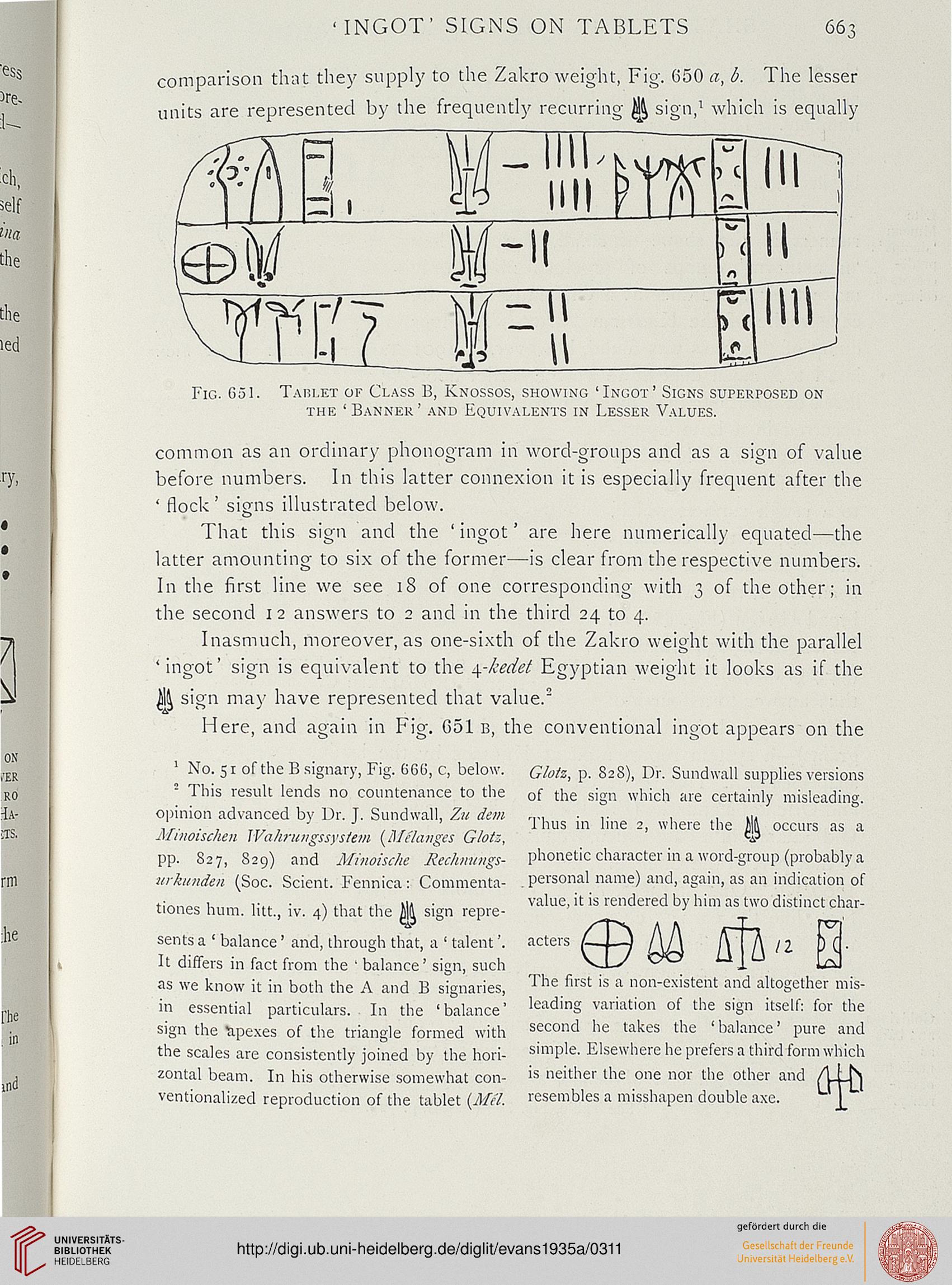INGOT' SIGNS ON TABLETS
663
comparison that they supply to the Zakro weight, Fig. 650 a, b. The lesser
units are represented by the frequently recurring- ^ sign,1 which is equally
/{6>.'l\
=3
ItZM
®v
M-w \
-<u
vim
vrr
f,7
I=li
Fig. 051. Tablet of Class B, Knossos, showing 'Ingot' Signs superposed on
the 'Banner' and Equivalents in Lesser Values.
common as an ordinary phonogram in word-groups and as a sign of value
before numbers. In this latter connexion it is especially frequent after the
' flock' signs illustrated below.
That this sign and the 'ingot' are here numerically equated—the
latter amounting to six of the former—is clear from the respective numbers.
In the first line we see 18 of one corresponding with 3 of the other; in
the second 12 answers to 2 and in the third 24 to 4.
Inasmuch, moreover, as one-sixth of the Zakro weight with the parallel
'ingot' sign is equivalent to the \-kedet Egyptian weight it looks as if the
ijfc sign may have represented that value.2
Here, and again in Fig. G51 b, the conventional ingot appears on the
1 No. 51 of the B signary, Fig. 660, c, below.
- This result lends no countenance to the
opinion advanced by Dr. J. Sundwall, Zu dem
Minoischen Wahrungssystem {Melanges G/otz,
pp. S27, 829) and Minoische Rechniings-
urkunden (Soc. Scient. Fennica: Commenta-
tiones hum. litt, iv. 4) that the M sign repre-
sents a ' balance' and, through that, a ' talent \
It diners in fact from the ' balance' sign, such
as we know it in both the A and B signaries,
in essential particulars. . In the 'balance'
sign the Upexes of the triangle formed with
the scales are consistently joined by the hori-
zontal beam. In his otherwise somewhat con-
ventionalized reproduction of the tablet {Mel
Glotz, p. 82S), Dr. Sundwall supplies versions
of the sign which are certainly misleading.
Thus in line 2, where the M occurs as a
phonetic character in a word-group (probably a
personal name) and, again, as an indication of
value, it is rendered by him as two distinct char-
acters©M I'2 E<•
The first is a non-existent and altogether mis-
leading variation of the sign itself: for the
second he takes the 'balance' pure and
simple. Elsewhere he prefers a third form which
is neither the one nor the other and
resembles a misshapen double axe.
op
663
comparison that they supply to the Zakro weight, Fig. 650 a, b. The lesser
units are represented by the frequently recurring- ^ sign,1 which is equally
/{6>.'l\
=3
ItZM
®v
M-w \
-<u
vim
vrr
f,7
I=li
Fig. 051. Tablet of Class B, Knossos, showing 'Ingot' Signs superposed on
the 'Banner' and Equivalents in Lesser Values.
common as an ordinary phonogram in word-groups and as a sign of value
before numbers. In this latter connexion it is especially frequent after the
' flock' signs illustrated below.
That this sign and the 'ingot' are here numerically equated—the
latter amounting to six of the former—is clear from the respective numbers.
In the first line we see 18 of one corresponding with 3 of the other; in
the second 12 answers to 2 and in the third 24 to 4.
Inasmuch, moreover, as one-sixth of the Zakro weight with the parallel
'ingot' sign is equivalent to the \-kedet Egyptian weight it looks as if the
ijfc sign may have represented that value.2
Here, and again in Fig. G51 b, the conventional ingot appears on the
1 No. 51 of the B signary, Fig. 660, c, below.
- This result lends no countenance to the
opinion advanced by Dr. J. Sundwall, Zu dem
Minoischen Wahrungssystem {Melanges G/otz,
pp. S27, 829) and Minoische Rechniings-
urkunden (Soc. Scient. Fennica: Commenta-
tiones hum. litt, iv. 4) that the M sign repre-
sents a ' balance' and, through that, a ' talent \
It diners in fact from the ' balance' sign, such
as we know it in both the A and B signaries,
in essential particulars. . In the 'balance'
sign the Upexes of the triangle formed with
the scales are consistently joined by the hori-
zontal beam. In his otherwise somewhat con-
ventionalized reproduction of the tablet {Mel
Glotz, p. 82S), Dr. Sundwall supplies versions
of the sign which are certainly misleading.
Thus in line 2, where the M occurs as a
phonetic character in a word-group (probably a
personal name) and, again, as an indication of
value, it is rendered by him as two distinct char-
acters©M I'2 E<•
The first is a non-existent and altogether mis-
leading variation of the sign itself: for the
second he takes the 'balance' pure and
simple. Elsewhere he prefers a third form which
is neither the one nor the other and
resembles a misshapen double axe.
op




